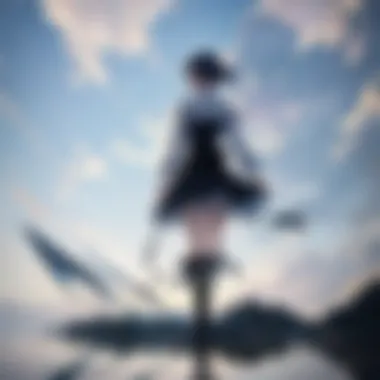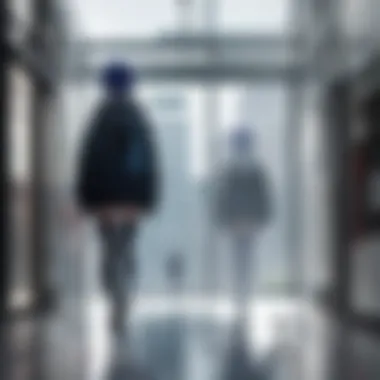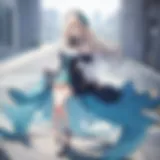Glass Reflection in Anime and Manga: A Deep Dive


Intro
The phenomenon of glass reflection in anime and manga encapsulates a rich tapestry of thematic resonance, artistic expression, and psychological nuance. This intricate device serves not merely as a visual flourish but as a poignant narrative tool that underscores characters' emotional states and conflicts. Through a careful examination of various works, we aim to uncover how glass reflections enhance storytelling, thereby fostering a deeper engagement for the audience.
In anime and manga, glass often symbolizes clarity, introspection, and the duality of reality versus perception. Characters confronted by their reflections can evoke a range of interpretations—from moments of self-discovery to the poignant recognition of their regrets or aspirations. This layered symbolism invites viewers to empathize with characters’ journeys, offering insight into their motivations and struggles.
The discussion around this motif will traverse the historical context of its use, exploring how artistic techniques in animation and illustrative styles have evolved over time. Additionally, we will consider various series that have utilized glass reflection effectively, shedding light on the implications for narrative progression and character arcs.
Ultimately, this article seeks to provide a comprehensive understanding of glass reflection in anime and manga, illustrating its impact not only on visual storytelling but also on the deeper emotional experiences it evokes in viewers.
Prolusion to Glass Reflection in Anime and Manga
Understanding glass reflection in anime and manga offers insight into visual storytelling. This concept is not just about aesthetics; it also involves deeper meanings and cultural contexts. In these media forms, glass reflections can serve as a narrative device, highlighting characters' inner thoughts or emotions. Their use often correlates with critical themes such as identity, duality, and memory.
The importance of this topic extends beyond the sheer artistry involved. Glass reflection acts as a bridge between the viewer's perception and the characters' realities. It prompts the audience to ponder the nature of self and the transparent boundaries between fantasy and reality. This exploration can enhance emotional engagement and deepen the viewer's understanding of a storyline.
Moreover, the examination of glass reflection challenges creators and viewers alike to appreciate more than just superficial visuals. It invites analysis of artistic choices, encouraging a holistic view of narrative structure and thematic depth. With this in mind, we can now define the term itself.
Thematic Significance of Glass Reflection
The role of glass reflection in anime and manga extends beyond mere visual appeal; it serves as a crucial thematic device. It enhances storytelling by embedding deeper layers of meaning within the narrative. The reflections often symbolize the inner thoughts and struggles of characters, allowing viewers to connect on a more personal level. This technique can reveal their vulnerabilities, aspirations, and conflicts, leading to a rich exploration of their identities.
Notably, glass reflection facilitates a dialogue between the character's exterior and interior worlds. It embodies duality, illustrating how characters may appear one way to the outside world while feeling differently internally. For audiences, this offers a chance to reflect on their own identities, thereby fostering a relatable experience. As such, reflections in glass become powerful tools in character development and emotional engagement.
"In every reflection, there lies a story untold, a truth waiting to be uncovered."
Symbolism of Reflection
The symbolism associated with glass reflection varies significantly across different series. In many cases, it acts as a metaphor for self-perception and the complexity of personal identity. Characters might look into a reflective surface not only to see their physical selves but to confront their emotional realities. The reflective surface often delineates the line between self-awareness and self-deception.
In series like Death Note, the protagonist, Light Yagami, uses reflective surfaces to visualize his descent into darkness. The reflection serves as a constant reminder of his moral dilemmas and the path he chooses. Thus, reflections can visually represent the tensions within a character, illustrating their hopes and fears in a visually compelling manner.
Furthermore, reflections convey themes related to memory and nostalgia. For instance, in Your Name., mirrors and reflections connect characters across time and space, creating a poignant exploration of longing and connection. This type of symbolic representation leaves a lasting impact, encouraging audiences to contemplate their experiences and connections in the real world.
Contrasting Realities
Glass reflections often depict contrasting realities, enhancing the narrative by juxtaposing different facets of life. Characters may encounter reflective surfaces during pivotal moments, where truths are revealed. These contrasts highlight the disparity between a character’s desires and their lived experiences. In Sword Art Online, reflection techniques showcase the stark contrast between the virtual world and reality. A character’s reflection in the glass serves as a reminder of their plight; the avatar they control does not match their true self.
Moreover, these contrasting realities create tension within the story. For example, reflections can reveal secrets or inner conflicts that characters struggle to acknowledge. By using glass as a visual element, creators introduce layers of complexity that challenge characters to confront their reality. The audience witnesses their journey towards acceptance or change, making the narrative more immersive.
In summary, the thematic significance of glass reflection in anime and manga cannot be understated. It offers layers of symbolism and contrasts that enrich storytelling, making character arcs more relatable and profound. By reflecting internal struggles and contrasting realities, creators invite audiences to engage in introspection, enhancing their overall viewing experience.
Artistic Techniques Depicting Glass Reflection
In the realm of anime and manga, the representation of glass reflection transcends mere visuals. It speaks volumes about the artistry and the deep storytelling methods employed by creators. Understanding the artistic techniques behind glass reflection is crucial for discerning fans. It enables them to appreciate the effort and creativity that goes into rendering these effects efficiently. Each detail plays a significant role in enhancing the narrative and mood of scenes, allowing viewers to connect emotionally with the characters.
Rendering Transparent Effects
The implementation of transparent effects in glass reflection is fundamental to achieving realism and depth. This involves a meticulous approach to illustrating objects behind glass or reflections on the surface. Artists often use layers to create a sense of space. By adjusting opacity and blending modes, they craft images that feel inviting and tangible. The challenge lies in maintaining clarity while reflecting light and surroundings. This technique draws attention and highlights important story moments. The graduating differences between fully opaque and transparent surfaces can introduce various emotional layers, thus making the scene more impactful.
Use of Light and Shadow


Light and shadow are pivotal in articulating the nuances of glass reflection. Proper manipulation of these elements can define a character’s state of mind or foreshadow plot developments. When light hits a glass surface, it creates reflections, refractions, and distortions. Artists strategically employ highlights to accentuate a character’s features, while shadows can envelop them in ambiguity or tension. This interplay can symbolize inner conflict or external struggles, making it a potent storytelling device. The effective use of light and shadow invites viewers to a deeper understanding of the narrative, urging them to read between the lines of the visual display.
Color Palette Considerations
Choosing the right color palette is essential to convey the right emotion in scenes involving glass reflections. Colors can evoke certain feelings and set the tone of a scene. For example, cool tones might suggest a sense of isolation or melancholy, while warm tones could hint at warmth and connection. Additionally, how colors appear through glass can alter their meanings. Subtle variations must be well thought out, as they affect the viewer’s perception significantly. Thus, color not only enhances the visual aesthetic but also serves to enrich the narrative depth of the storyline. Artists need to consider how these choices align with the overall themes of their works.
"The transparent effects, nuanced light, and thoughtful color choices in glass reflections provide greater insights into characters and plot developments."
The exploration of artistic techniques in depicting glass reflection reveals a rich landscape of creativity and thoughtful detail. Each technique operates in harmony with the others, contributing to the overarching tapestry that is the narrative. These elements together enhance the viewing experience, offering layers of meaning that engage anime and manga enthusiasts deeply.
Cultural Perspectives on Glass Reflection
The role of glass reflection extends beyond mere visuals in anime and manga; it's deeply rooted in cultural context. Understanding these perspectives provides insight into how reflections serve not only as aesthetic elements but also as carriers of profound thematic significance. Exploring these cultural backgrounds reveals how glass reflections echo the values, beliefs, and artistic expressions of different eras and societies. This section focuses on two main aspects: Japanese aesthetics and minimalist philosophy, as well as reflections found within Shinto and Buddhist ideologies.
Japanese Aesthetics and Minimalism
Japanese aesthetics emphasizes subtlety and simplicity. This cultural strain manifests itself in various art forms, including anime and manga. The concept of wabi-sabi, which finds beauty in imperfection and transience, aligns closely with how reflections are portrayed. Characters often engage with reflections in ways that highlight their internal struggles or fleeting moments of clarity.
Reflections serve as visual motifs that complement minimalist designs, echoing the philosophy of less is more. The portrayal of glass sometimes appears in scenes that evoke stillness and contemplation, allowing viewers to absorb the atmosphere. This focus on simplicity enhances the storytelling, encouraging the audience to engage with the characters’ experiences on a deeper level. The use of empty spaces, combined with reflective surfaces, enhances emotional narrative and prompts introspection.
Moreover, active reflections can symbolize the search for self-awareness amid complexity. The simplicity of reflected images invites viewers to find meaning within their own experiences. For instance, a character gazing into a calm lake may not only see their own face but also reflect on their life choices and emotions. This aligns with the principles of minimalism embedded within Japanese culture.
Reflections in Shinto and Buddhist Contexts
In both Shinto and Buddhist traditions, reflections often hold spiritual connotations. Shinto beliefs articulate a connection to nature and the sacredness of life, where reflecting surfaces, such as water, are seen as portals between realms. These surfaces can symbolize purity or clarity, representing a journey towards enlightenment or understanding.
Buddhism, on the other hand, engages with the concept of self-reflection as integral to spiritual growth. The mirror metaphor is commonly utilized in narratives to depict the path toward self-discovery. Through this lens, glass reflections transform into symbols that illustrate the quest for inner truth. Characters engage with their reflections in moments that signify transformation or revelation, reinforcing the importance of self-awareness.
"In Shinto belief, nature is seen as alive with spirits, and reflections become a bridge between the physical and spiritual realms."
The integration of these cultural elements into anime and manga emphasizes how reflections do more than represent images; they serve as conduits for the characters’ development and emotional journeys. In understanding these cultural perspectives, one gains a richer appreciation for the multilayered meanings that glass reflections provide in storytelling.
Psychological Interpretations of Reflection
The concept of glass reflection encompasses much more than a mere visual phenomenon; it delves deep into psychological dimensions that shape characters and narratives in anime and manga. This article examines how glass reflections act as vehicles for introspection, self-discovery, and identity exploration.
By using reflections, creators tap into the emotional states of characters, providing viewers a glimpse into their internal struggles and triumphs. The depiction of reflection often brings about a significant understanding of the character’s motivations and desires. This psychological interpretation enriches the storytelling, allowing for a multidimensional exploration of characters' psyches.
Introspection and Self-Discovery
Introspection is a core theme surrounding the motif of reflection in anime and manga. When characters encounter their reflection in glass, it can often trigger moments of self-examination. This examination may arise during critical turning points in their stories where they face moral dilemmas or conflicts.
In various series, the glass reflection signifies more than just an image; it becomes a point of contact for characters to confront their innermost feelings and thoughts. For instance, characters may find themselves questioning their past actions or contemplating their futures. Through these reflective moments, audiences witness the evolution of characters as they navigate through complex emotions, reinforcing the narrative depth.
Moreover, such moments can lead to important transformations. Characters who engage with their reflections often undergo significant emotional growth, understanding who they truly are within the fabric of their surroundings.
The Mirror as a Metaphor for Identity
The mirror, or glass reflection, also serves as a powerful metaphor for identity in anime and manga. It encapsulates the essence of how individuals perceive themselves versus how they are perceived by others. This duality often exposes themes of authenticity, self-image, and societal expectations.
Characters may grapple with fulfilling roles imposed by society or family, leading to conflicts between personal desires and external pressures. In this context, the glass reflection symbolizes the ongoing struggle to reconcile these aspects of identity.
For example, in notable series like Your Name., the mirror becomes a device that reveals the character’s true self, prompting a journey of realization and acceptance. This struggle signifies a universal experience, making such depictions resonate deeply with audiences.


"Reflections serve as a canvas for characters to explore their true selves, leading to transformative journeys of discovery."
Understanding these psychological dimensions can offer anime and manga enthusiasts a richer perspective on their favorite series.
Character Development through Glass Reflection
Glass reflections in anime and manga serve a pivotal role in character development. This phenomenon goes beyond mere aesthetics; it brings emotional depth and reinforces narrative arcs. By utilizing reflections, creators can convey significant aspects of a character's journey, showcasing their internal struggles and transformations. Whether through a literal depiction of a character looking into a glass surface or through symbolic frameworks, reflections offer profound insight into their psyche.
Moments of Revelation
In many narratives, moments of revelation characterized by glass reflection highlight critical turning points for characters. These instances often manifest when a character faces their true self, confronting hidden fears or desires. For example, in the film "Your Name," the protagonist's encounter with their reflection serves as a moment of critical self-discovery. This revelation propels the narrative forward and deepens the audience's understanding of the character’s emotional landscape. Such scenes can evoke empathy and invite viewers to reflect on their own experiences of realization.
- Key Aspects of Moments of Revelation:
- Catalyze character growth
- Illuminate hidden motivations
- Engage the audience emotionally
These reflection moments can resonate on a deeper level, emphasizing the theme of identity. As characters face their reflections, audiences see dualities or conflicts represented visually. This adds layers to storytelling, allowing exploration of more profound issues, such as self-acceptance or the struggle between societal expectations and personal desires.
Conflict and Resolution Reflections
Conflict and resolution reflections play a vital role in shaping character arcs. Often, these reflections highlight the tension characters face, both internally and externally. For instance, in "A Silent Voice," characters wrestle with their past through graphic depiction of reflections. As they confront their failings and learn to forgive themselves, the reflections become symbols of the transformation process.
In these narratives, glass reflections represent not just the characters themselves but also the obstacles they must overcome.
- Transformative Elements:
- Showcasing the evolution of character relationships
- Emphasizing struggles with personal demons
- Resolution often marked by a decisive encounter with one's reflection
The resolution often showcases a character’s newfound understanding or acceptance. With the use of visual storytelling, these reflections facilitate a deeper comprehension of the character’s development journey.
Notable Examples in Popular Series
In the realm of anime and manga, the portrayal of glass reflection serves as a powerful narrative tool. It not only enriches the visual experience but also deepens the psychological dimensions of characters. The exploration of notable examples helps clarify how different series utilize this artistic element effectively to convey themes and emotions.
Key Scenes in 'Your Name.'
'Your Name.' directed by Makoto Shinkai exemplifies the use of glass reflection with remarkable efficiency. One of the most notable scenes involves the characters Mitsuha and Taki, who find themselves connected despite the barriers of time and space. The glass reflections serve as visual metaphors for their yearning to understand each other and bridge their disparate worlds.
The moment when Taki looks into the reflective surface of the water, contemplating his lost connection with Mitsuha, is especially poignant. The rippling surface alters their images, symbolizing how their lives are intertwined yet remain elusive. This scene underscores the transient nature of relationships, making viewers reflect on their own connections.
Reflections in 'Sword Art Online'
In 'Sword Art Online,' glass reflection is utilized in a different yet equally engaging manner. The virtual world, specifically in the early arcs, comprises numerous environments filled with stunning visuals and reflective surfaces. In premium sequences, protagonists Kirito and Asuna encounter scenarios where reflections prompt a sense of duality.
For instance, scenes in Aincrad feature glass panels or water surfaces that echo the characters' hidden emotions. The reflection becomes a lens through which their inner struggles and desires are revealed. It reveals aspects of their personalities that they hide from others, enhancing character depth. This technique fosters a connection between the audience and the characters, allowing viewers to resonate with their inner challenges.
Analysis of 'A Silent Voice'
'a Silent Voice' brings another layer of understanding to the usage of glass reflection. The film explores themes of bullying and redemption, employing reflections to signify guilt and self-awareness. The protagonist, Shouya, faces his past, often seeing his reflection in various glass surfaces. It serves as a reminder of the hurt he caused others, particularly to Shoko, the deaf girl he bullied.
In several crucial moments, the reflections symbolize Shouya's self-reflection journey. He confronts the consequences of his actions and seeks forgiveness. The glass not only highlights his emotional turmoil but also serves as a pivotal narrative device for character development. Each sighting of his own reflection acts as a catalyst for change, revealing the potential for growth and healing.


In summary, notable examples from 'Your Name.', 'Sword Art Online', and 'A Silent Voice' illustrate how glass reflection is intricately woven into the narrative fabrics of anime and manga. Each series uses this artistic technique to enhance thematic resonance, character complexity, and emotional depth.
Impact on Audience Perception and Reception
Understanding the impact of glass reflection in anime and manga is essential. This phenomenon does not serve merely as an aesthetic choice; instead, it plays a crucial role in shaping audience perception. When viewers see reflections in glass, it evokes emotional responses that transcend simple visuals. These reflections often symbolize deeper themes, nostalgia, and the duality of existence.
The use of glass reflection can enhance dramatic moments. Cinimatic and anime scenes often utilize reflective surfaces for highlighting a character's internal conflict. These visually captivating moments provide significant narrative weight. By engaging audiences on an emotional level, creators encourage viewers to reflect on their interpretations.
Emotional Engagement through Visual Storytelling
Visual storytelling is central to anime and manga, representing complex emotions effectively. Moments that feature glass reflections can invoke a range of emotions. For instance, in contemplative scenes, reflections can symbolize isolation or introspection. When a character looks into a glass surface, audiences may share a moment of realization, prompting personal connections to their own experiences.
This engagement is often reinforced through detailed artistry. When artists render light and color on reflective surfaces, the visual depth adds to the storytelling. The audience is drawn into a moment, where they sense the weight of what the character feels. This method accentuates the emotional narrative, encouraging viewers to find personal meaning in the content.
"In visual storytelling, every element resonates with an audience's emotional journey."
Audience Interpretation of Reflected Themes
Reflected themes can vary significantly from person to person. Audiences glean insights from reflections based on their background and life experiences. For instance, a character’s reflection might represent missed opportunities or alternate choices. These thematic elements invite viewers to reflect upon their interpretations rather than providing definitive answers.
Creators recognize the complexity that glass reflections add to the narrative. By portraying several layers of meaning through reflections, they enhance the story's richness. Audiences actively participate in this dialogue, interpreting reflected imagery in accordance with personal beliefs and feelings.
Moreover, discussions that arise around these themes foster community and connection. Fans often delve into the meaning behind specific scenes or characters, leading to shared understanding. This dynamic interaction increases the relevance of glass reflection as a narrative device.
Future Trends in Depicting Glass Reflection
The exploration of glass reflection in anime and manga is evolving rapidly, influenced by technological innovations and shifting artistic styles. Understanding future trends in depicting glass reflection is crucial because it will shape how narratives unfold visually. This section looks into newer tools and techniques that can enrich the portrayal of glass reflections, focusing on their relevance in storytelling.
Advancements in Digital Animation Techniques
Recent years have seen substantial advancements in digital animation technology. These developments allow for increasingly realistic representations of glass reflection in anime and manga. Techniques such as ray tracing, which simulates the way light interacts with surfaces, enable animators to create lifelike reflections that enhance the visual quality.
Artists can now manipulate transparency, refractions, and distortions more efficiently. This results in more immersive storytelling experiences. For instance, series that incorporate detailed environments may use these techniques to reflect characters' emotions or thoughts, deepening the viewers’ connection to the narrative.
Integration of Technology and Artistry
The confluence of art and technology in anime and manga is more apparent than ever. With tools like Photoshop and Clip Studio Paint, artists can apply complex filters and layers that mimic real-world glass effects. This blending of technology with traditional artistry enriches the final outcomes, allowing for explorations of themes like duality and identity through visual cues, notably in reflections.
Moreover, platforms such as Reddit and various social media forums encourage discussion among artists about techniques and software. This creates a community for sharing innovations, which can inspire up-and-coming creators. It also means that the application of glass reflections can be both a personal expression and a technical challenge, where every project might push the boundaries of what is achievable in animation.
"As technology progresses, the resonance of glass reflections in storytelling will only strengthen, bridging fantasy and reality in unique ways."
These trends signal a vibrant future for anime and manga as creators continually explore new expression avenues. It is vital for enthusiasts and critics alike to keep an eye on how these methods develop, as they will influence narrative structure and viewer engagement profoundly.
Closure
The topic of glass reflection in anime and manga serves as a crucial element in understanding not just the visual aspects of these mediums but also their deeper thematic layers. The analysis throughout this article has highlighted various facets of glass reflection, revealing its significance in character development, narrative depth, and emotional engagement.
Recapitulation of Key Themes
In summary, several key themes emerge when we look at glass reflection:
- Symbolism: Glass reflection often symbolizes inner struggles, emotional turmoil, and personal revelations in characters.
- Cultural Context: The ties to Japanese aesthetics and spirituality give a cultural dimension to these reflections, enriching viewer interpretation.
- Artistic Techniques: The ways artists employ light, shadow, and color to create transparent effects enhances the visual narrative and communicates complex emotions.
- Psychological Layers: Glass serves as a metaphor for identity, introspection, and the conflict between one’s public persona and inner self.
These themes demonstrate how the use of glass reflection transcends mere aesthetic appeal, fostering emotional connections and prompting introspection among viewers.
The Lasting Influence of Glass Reflection
Glass reflection in anime and manga has left a lasting impact on the way stories are told in these mediums. The subtle use of reflective surfaces encourages audiences to ponder their own identities and struggles. This interplay between visual storytelling and audience interpretation creates an engaging experience that resonates deeply. Furthermore, as technology evolves, the methods of depicting glass reflections are becoming increasingly sophisticated. This evolution promises to further enhance its role in narrative development.







